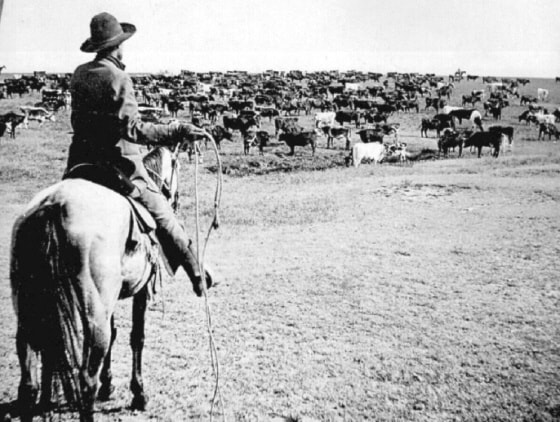In the early days of the settlement of our wild-wild west it would be massive herds of cattle that were so vital to the livelihood of those hardy farmers and ranchers who were striving to establish a new home in a very harsh new environment. Raised on the tall and rich grass of the rolling pastureland, they thrived and multiplied in great numbers, then were driven to the markets, where they would hopefully bring a fair price and a bright future. It was there, along the dusty trails of the rugged prairies where the wild and tough skills of the ranch hands were earned the hard way, and also, when there was a little time for fun after long day’s work, where the exciting sport of rodeo and the early antics of the cowboy were born.
A chilly winter cattle drive.
An early tale in the Mecca Glen Memories history book by Water Glen pioneer E.G. Boddy tells of getting into the cattle business in the very early 1900s. Boddy vividly recalls the brutal winter of 1906-1907 when the family was fattening 48 head of steers, and the temperatures dipped at night to 60 degrees below zero for six week’s steady. The hay that they had purchased had to be hauled four or five miles, and on many occasions it was snowing and blowing so hard that you couldn’t find the stacks or the wandering cattle.
The grain for feed was ground by a two-horse grinder and the water was pumped by hand, and it took a lot of both as their hefty herd of 28 steers averaged over 1800 pounds. When Mr. James, the head buyer from Swifts of Chicago visited the farm, he claimed that they were the best steers he had ever seen and would pay six cents a pound and haul them to the States, but unfortunately the Boddy family had already agreed to sell them for 4 ½ cents. They had to be delivered to the Ponoka stockyards by April 26th, but the snow was so deep, the wagon drivers had to go ahead in single file with the feed grain and hay. It would take three gruelling days for the herd to reach Ponoka, where the whole crew had to bunk in for two nights, and where the owners would realize that after paying for all the feed as well as the interest on the bank loan, they certainly did not make their fortune on this venture. Ironically it was later announced on the radio by Alberta Minister of Agriculture Strome that our farmers were feeding the Province for almost nothing.
In 1912 the Boddy clan became the first family in Water Glen to attempt growing wheat, had an amazing crop, which sold for 87 cents a bushel, and established the reputation that their district was the best for mixed farming. The same year they also sold the first cows to the new Ponoka Mental Hospital farm, but were nearly eaten alive by mosquitoes while taking them over the flats to Asker. In 1913 a severe wind storm hit the district, causing all sorts of damage, as well as high waves on Red Deer Lake that swamped many boats. The same year many of the district men enrolled in the Canadian forces, and in the winter had to walk across the ice of Red Deer Lake to catch a train at Ferintosh, which took them to Edmonton for training and assignment overseas. Mr. E.G. Boddy and Archie Billinghurst sold their farm and enlisted in the 187 Battalion, which was based in Calgary.
The first Alberta Cattle King.
George Lane was a colorful early cattle man and master of cowboy skills who moved to the District of Calgary in 1884 to take on the job of the foreman of the North West Cattle Company’s massive Bar U Ranch. He would quickly become one of a handful of experienced American cowboys who pioneered and guided the day-to-day cow/calf operations on large-scale Canadian ranches, some of which went on to be rated amongst the largest in the world.
In 1902 Lane purchased the Bar U Ranch, adding to his massive cattle kingdom, which already included the YT Ranch on the Little Bow River and the Willow Creek Ranch in the Porcupine Hills. While constantly training new cowhands and always expanding, he made use of the vast expanses of short grass on the open range between the Bow River and Red Deer. It was estimated that at the peak of his empire George Lane was running between 16,000 and 18,000 head of cattle on his properties with minimum supervision, and had yet to be effected by later invasion of farm settlement.
He later argued that the homesteaders would need an enormous number of draught horses for their operations, and during the first two decades of the century would build up one of the largest Percheron herds in the world, which included classic mares and sleek powerful stallions that weighed over a ton. Also a strong advocate of mixed farming, Lane would purchase the 10,000 acre Namaka Farms in 1913, and by 1915 had become one of Alberta’s largest grain growers. Record yields in 1916 made him even richer, but then a dry cycle brought sudden disaster, many of his mega-properties had gone back to the Dominion Bank by 1922, and he passed away at the age of 69 in 1925 after an amazing, colorful, and mostly successful life. We salute farmers and ranchers of then and now, for their ongoing and undying desire to work hard and succeed, while facing countless challenges and many seasonal elements along the way.
